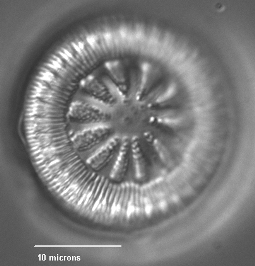Everybody’s got a summit nowadays. Last week, while the governors were doing their climate summitry in L.A., scientists and policy wonks convened at U.C. Davis for an ag-and-climate “summit.” The discussions seemed interesting and productive, despite (or perhaps because of) the fact that no world leaders appeared. This week the gods of green goop are gathered in San Diego for an Algae Biomass Summit. Climate Watch contributor and climate scientist Abbie Tingstad explains why algae deserves a summit.
 The Power of Pond Scum
The Power of Pond Scum
By Abbie Tingstad
The slimy yellowish brown muck known as “pond scum” may soon help fuel your car, make your airplane trips more environmentally friendly, and power your home. Scientists and start-ups around the world are now looking to tap into this unsightly source to produce ethanol, biodiesel and jet fuel, and even more efficient solar cells. This sustainable energy source consumes carbon dioxide and can be developed without competing with food crops for land.
Yellow-brown pond scum is composed of diatoms; single-celled algae with elaborate silica-based cell walls (green films on water are made up of other types of algae and small water plants). These primary producers are ubiquitous: they inhabit a wide range of environments, requiring only sufficient light for photosynthesis and enough moisture to prevent desiccation. Worldwide, there may be 100,000 species living in oceans, lakes, estuaries, rivers, swamps, moist soils, and other damp environments.
Climate and environmental researchers have taken advantage of diatoms’ cosmopolitan living habits to reconstruct past climates and infer recent environmental changes related to pollution and climate warming. Since different locations tend to have unique diatom community compositions, these tiny algae have also helped forensic investigators solve crimes.
Now, diatoms and other types of algae and small aquatic plants like duckweed and watermeal might be used to generate ethanol, biodiesel, and jet fuel. A number of start-ups, such as Aurora Biofuels and SunEco Energy in California, have begun developing technologies to “farm” algae on non-agricultural land, using salt-or lower-quality fresh-water and also just happens to consume carbon dioxide. This research has seen renewed interest at large laboratories such as the National Renewable Energy Laboratory (NREL). Big private-sector players, such as ExxonMobil, Chevron, Dow Chemical, and Honeywell International, have begun investing in research as well.
Diatoms may also be able to make solar cells more powerful, according to recent research out of Oregon State University and Portland State University. Unlike more conventional silicon-based cells, dye-sensitized solar cells, which absorb photons on a dye molecule thin-film joined to a layer of titanium oxide on glass or plastic, are made from environmentally neutral materials and work well in lower light conditions. Using diatoms to coat the dye-sensitized solar cells could triple their efficiency, making them more competitive with silicon cells.
These diatom-based technologies are still in their infancy so it’s difficult to determine whether they’ll make a meaningful contribution to a new wave of renewables. However, California may well benefit if they do become more widespread because these can potentially be operated on dry land and, in the case of fuels, using salt water.
With these technologies still in their infancy, it’s not clear how soon, if ever, they’ll become widespread. However, with its surfeit of sunshine and lots of available desert land and access to saltwater, California stands to benefit from an algae boom, should investors wade in.
Abbie Tingstad is finishing her Ph.D. in the Department of Geography at UCLA, where she specializes in the analysis of tree-rings and diatoms (environmentally-sensitive unicellular algae) to infer information about climate and environmental change.
Behold the power of pond scum in the recent television segment produced by KQED’s Quest.
